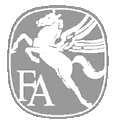
Fairchild 22 History |
| Home > Williams Aircraft Collection > Fairchild 22 > History | |
|
The Fairchild 22 was built during the early 30's by the Fairchild Aircraft Company's Kreider-Reisner division in Hagerstown, Maryland. The KR company had been building Kinner powered biplanes such as the KR21 and KR34, but when the stock market crash and depression struck, these planes were too expensive and were not selling well. Fairchild responded with a simpler and inexpensive design with a parasol wing which was the Fairchild 22. First built in 1931 and initially selling for $2675, the 22 was a success and was widely used as a trainer as well as a sport plane. The 22 was produced until 1935 when production was halted due to changes in the marketplace which required higher performance and the comfort of enclosed cockpits. The successor to the 22 was the enclosed cockpit Fairchild 24, which is very recognizable as being related to the 22 because of similar outrigger landing gear structure and the distinctive Fairchild vertical stabilizer shape. The various models of Fairchild 22 are distinguished by the type of engine installed.
Early 22's were built with inline engines, and the resulting aircraft had a small frontal profile and a dainty appearance. This is a B-model:
The B model is what I think of as the quintessential Fairchild 22, although there were more of the Cirrus powered versions built. There are very few of the Menasco powered 22's still flying, and almost none of the Cirrus or Gypsy powered versions. Starting in 1934 the Fairchild 22 was changed to use a Warner radial engine (check out this old Warner engine advertisement). This caused the fuselage to be contoured to match the larger frontal profile of the radial and as a result the aircraft appears to be much beefier. A cowling was also installed and fairings added around strut junctions to reduce drag. Fairchild 22's seem to have a pattern of breaking up in flight when used for hardcore aerobatics. Several of the currently flying aircraft were rebuilt from a dataplate and a few pieces of bent metal. Bill Worman of Orcas Island, WA has rebuilt a 22 C7B and says that a stress analysis performed by an aeronautical engineering professor friend showed that the main struts are very weak in compression, which would account for failures during aerobatic flight. His recommendation is to reinforce these struts. The airframe was apparently strengthened in the final C7G model version, which is reputed to have type certificate stress limits of 10 positive Gs. Some of these aircraft were converted later in life to use a Lycoming R680 220hp engine, which is a monster engine for the size of the aircraft but would probably make for a great aerobatics show plane. |
||